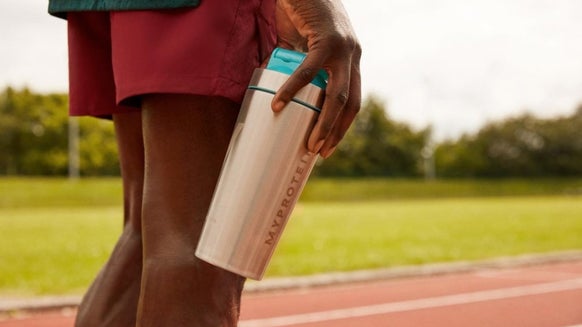How to Get Ripped in 8 weeks
Ripped in 8 weeks
In the modern age, 8 weeks seems like a long time to get ripped doesn't it?
In actual fact, with a gentle bit of internet perusing you can even get ripped in as little as a week, although I wouldn't recommend doing so.
When exploring the quest to get ripped it should be noted that the average length of time an IFBB professional bodybuilder spends dieting for a contest is 14 -20 weeks. Their aim is to step on stage with body fat levels of about 3%.
For most people this is neither necessary nor obtainable. However, a bodyfat percentage of 9% or lower will have heads turning on any beach in the summer. Depending on a number of factors, including genetics, a sub 9% bodyfat index should result in a clearly visible 6 pack and some elegant striations.
Utilise your Afterburners using Resistance Training
Resistance training has effects that extend beyond the point where you place that dumbbell neatly back on the rack. In fact resistance training has been shown to elevate your metabolism for up to 36 hours post workout. This effect is so pronounced that resistance training has been shown to have an absolute effect of increasing your resting metabolic rate (RMR) (1).
This is due to the cost of breaking down and rebuilding muscle which incurs a significant metabolic cost. However, this elevated RMR will only be experienced by utilising short rest periods between sets and maximising training intensity. Traditional steady-state cardiovascular activity does elevate RMR to an extent, but it also elevates the stress hormones epinephrine and cortisol (2), which can in turn promote muscle catabolism.
In actual fact, cortisol directly affects fat storage and weight gain in individuals whose bodies are placed under stress. It is worth remembering that long periods of steady state cardio will make your body react as if placed under stress. It is also worth noting that there are higher levels of cortisol receptors found in the abdomen than in other parts of the body, which unfortunately means this area is more predisposed to fat storage.
Despite this, cardiovascular activity is still an essential tool to maintain a calorific deficit. In order to lose body fat it is important to use slightly more calories than you ingest. Over a period of 8 weeks this doesn't, and shouldn't be a huge calorie deficit as there is always a risk of becoming catabolic. The deficit can be created in one of three ways; an increase in activity, a decrease in calorie intake or both.
The most effective strategy would normally involve the conservation of muscle for as long as possible by doing the minimum amount of cardiovascular activity whilst keeping calories as high as possible.
Ultimately, this strategy will result in a plateau where no further fat loss is possible. At this point you can once again take one of three options; introduce cardiovascular activity to the programme, reduce calorie intake or both. With a programme spanning 8 weeks it is always best to maintain a slight calorie deficit rather than a drastic one in order to prevent the catabolism of muscle tissue.
Perform cardiovascular activity at the optimal time for fat loss
The optimal time to perform cardiovascular activity is when your glycogen levels are at their lowest. Glycogen acts as a form of energy storage and is found in muscle and liver cells, its presence will prevent fat from being used as energy during cardiovascular activity.
Glycogen levels are at their lowest first thing in the morning, before eating (or after any period of fasting), and straight after a resistance based workout. Training pre-breakfast can burn 20% more fat. There are suggestions that this can lead to muscle catabolism but using a combination of BCAAs, glutamine and creatine can help to preserve muscle tissue during cardiovascular activity.
In terms of activity, it has always been thought that low intensity cardio was optimal from a fat burning perspective. However, this view is now considered to be somewhat antiquated considering the added fat loss effects provided by high intensity interval training (HIIT).
HIIT provides a greater fat loss in a shorter amount of time (3). HIIT would appear to be the best fat loss option for most people assuming that any carb reduction doesn't render high intensity training impossible. It is also worth noting that long periods of low intensity cardio can also result in a heightened cortisol response and subsequent fat accumulation in the midsection (4).
Remember that during this 8 week programme there will be numerous occasions when you hit a plateau and have to either reduce your calories, increase your activity or both. Unless you want to find yourself in a situation where the only option is to do 2 hours of HIIT a day then it is important not to start off with your calories and carbohydrates to low.
Once your calorie level gets too low it is also inevitable that you will start to catabolise muscle tissue. A good indicator of your daily calorific needs can be calculated using the Harris Benedict Formula. However, in order to allow for your calorie deficit a good rule of thumb is to multiply your weight in lbs by 15 (for a 200lb man, 200x15 = 3000).
The ratio of the three macronutrients is also important with a good starting point being 40% carbohydrates, 40% protein and 20% fats (good dietary fats). If at any point you find you are unhappy with your fat loss progress, it is your carb intake that should be altered. If you find you are losing weight too quickly and feel you are catabolising muscle then increase your carb intake. If you feel you are holding onto too much body fat then reduce your carbohydrates.
Calorie counting isn't a method used by the majority of bodybuilders, but those who do also like to keep a close eye on their protein and carbohydrate intake at every meal. A typical 200lb man would need to start on 3000 calories a day which would equate to; 300 grams of protein, 300 grams of carbohydrates and 67gms of fats a day.
This would seem like a big quantity of food to eat, which is why it is typically spread across 6 meals throughout the day. In terms of optimal protein per meal it is probably best to stay under 40grams a meal. For a 200lb man this would equate to 6 meals and 2 protein supplements to obtain the subsequent protein. Carbohydrates are best drawn from the complex and fibrous variety. We've produced a full breakdown of the best carbohydrates on our site.
Complex carbohydrates lack the pronounced insulin spike produced by simple carbohydrates and release energy slowly over the course of the day. Fibrous carbohydrates produce a very small insulin response making them ideal for forming the basis of any fat loss diet, and the main constituent carbohydrate of any fat loss diet. As you get closer to your goal deadline you can alter the ratio of fibrous to complex carbohydrates in order to continually lose fat. If you're struggling to hit your dietary fibre requirements, don't go any further than our curated list of the best fibre supplements available.
As the plateaus become harder to overcome is it also worth using carb cycling to maintain your body? Effective carb cycling involves varying the amount of carbohydrates you consume on a daily or weekly basis. One carb cycle many people find effective is a 3-1 split, 3 days without carbs (fibrous vegetables allowed) followed by 1 day with carbs.
The core of any programme aiming to maintain muscle mass whilst reducing body fat is resistance work. A basic routine schedule would involve 6 resistance based workouts lasting 45mins-1hour supplemented with 15 minutes of HIIT (either pre-breakfast or post workout). Each set should consist of 10-12 reps with shortened rest periods of 30-45 seconds to promote muscle hypertrophy and fat loss (Villanueva et al., 2012).
References
1. Hambre et al. Scandinavian Journal of Clinical and Laboratory Investigation 2012 Oct;72 (6):471-8 2. Shojaei et al. International Journal of General Medicine 2011 Jan; 24 (4):79-84 3. Tremblay et al. Metabolism. 1994 Jul; 43 (7):814-818 4. Maglione-Garves et al. ACSM?s Health and Fitness Journal. 2005; 9 (5):20-23 5. Villanueva et al. Journal of Strength and Conditioning Research 2012 Oct;26(10):2755-64.



